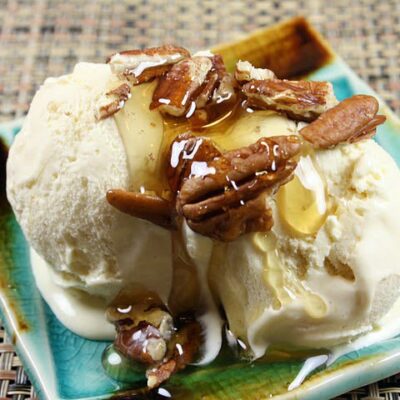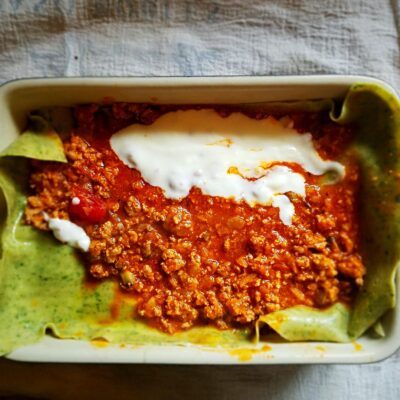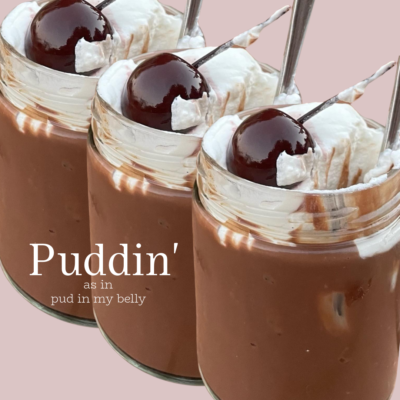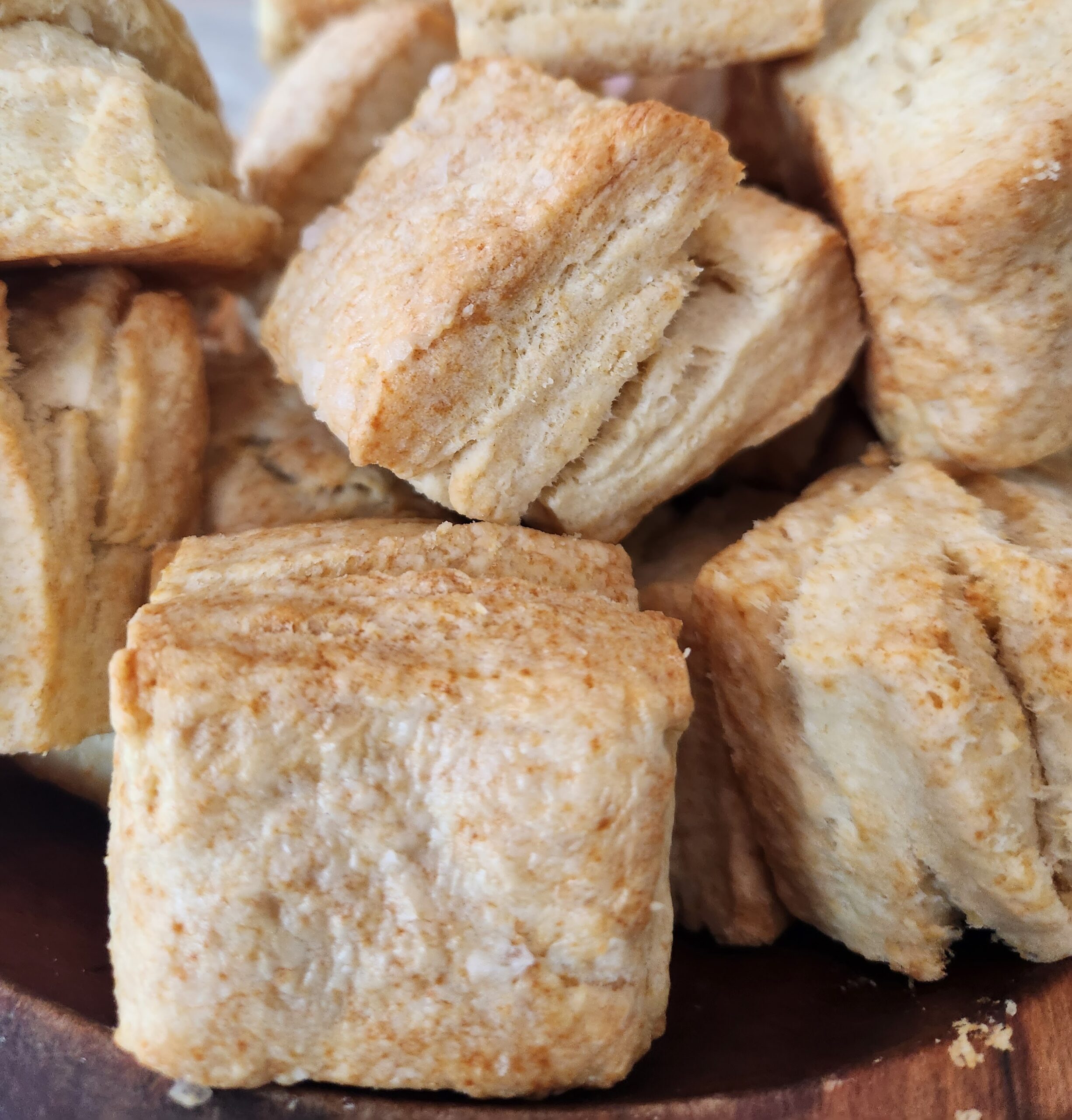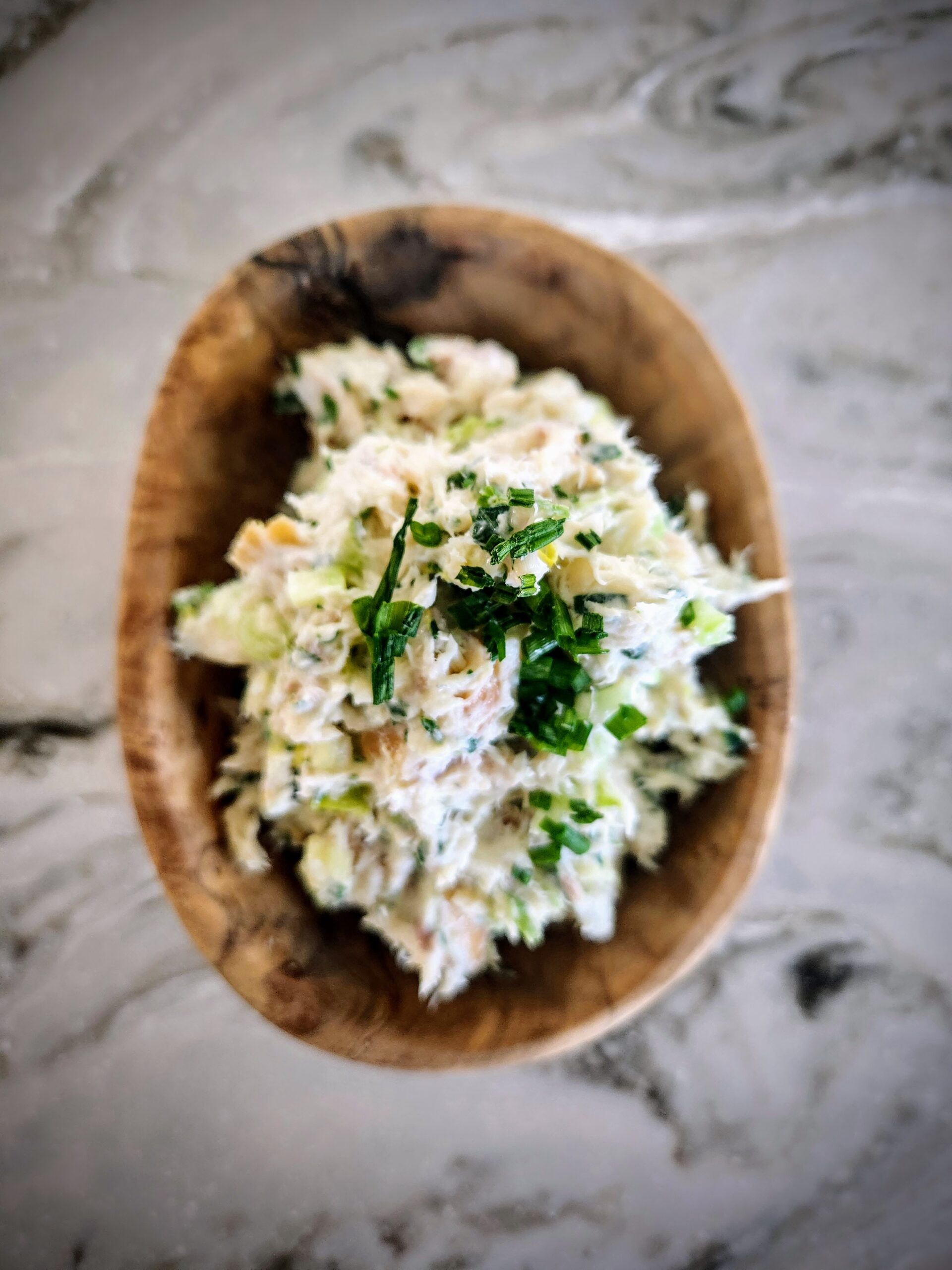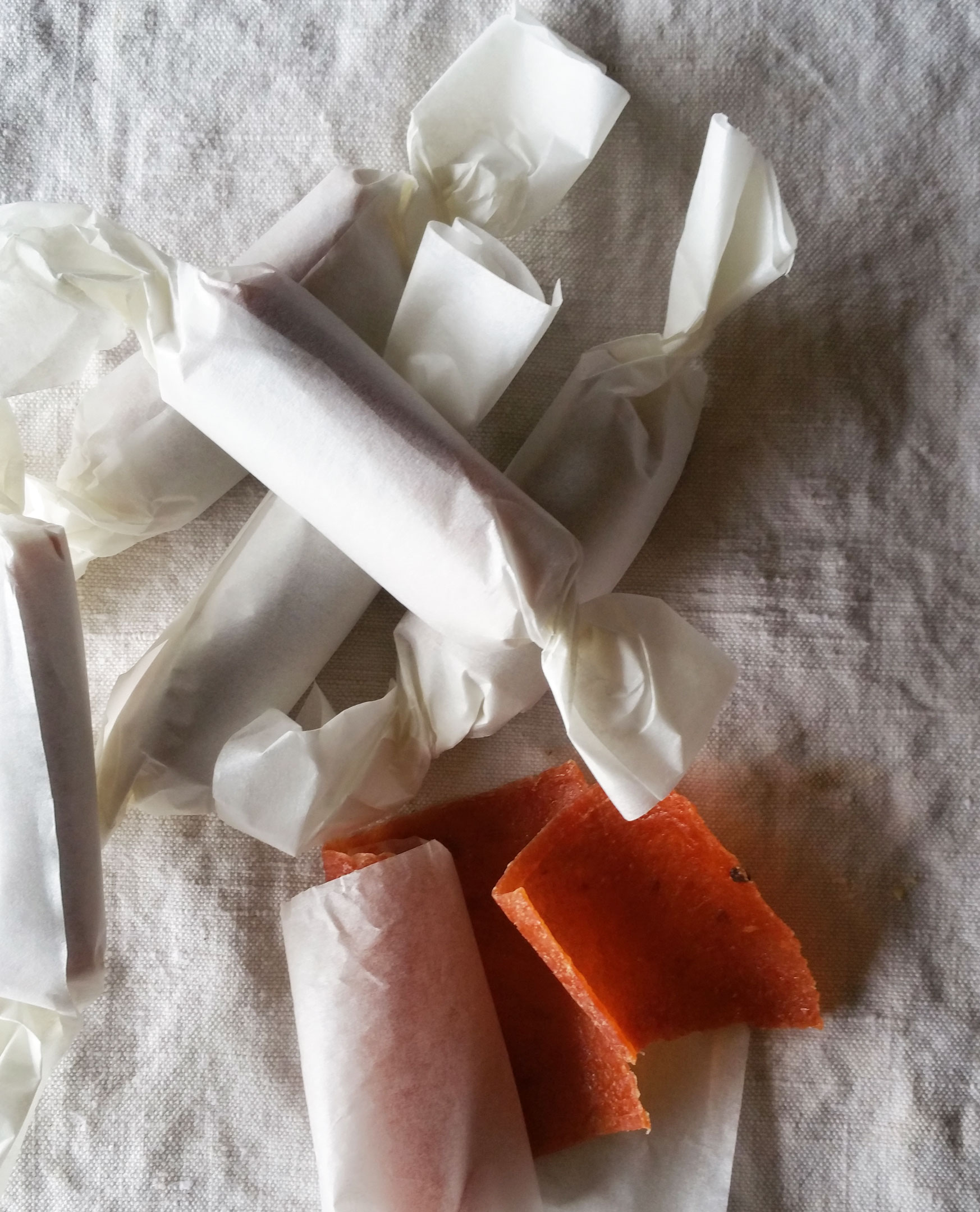
Quince Fruit Leather
On December 5, 2014 by sixtyacrebakerAs a kid, I brought a sack lunch to school every day…as did most of my classmates. What I would never find packed in my lunch were modern day snack foods. I was always trying to trade up for fruit roll-ups. Oh how I loved them. The whole thing…the sound the leather made while being ripped off its backing. Eating it piece by piece…or better yet…making a dense chewy mini roll-up which would burst with flavor at every gnash. Apricot was always my favorite. I would trade my best halloween candy for a roll of apricot.
I learned to make fruit leather in fancy french culinary school. It was a bit of a production; mostly because it was fancy culinary school. Making fruit leather is simple and easy, and extremely satisfying. I love it because it gives a use for the “dregs” from another product: the pulp from jelly making, juicing, and simple syrups. I made a lovely quince sorbet as a palate cleanser for our Thanksgiving dinner {recipe coming soon}. I boiled down the beautiful fruit and extracted a lovely pink elixir. At the end of it all, I was left with a bundle of fruit. It was a bit chunky, and was lacking sweetness. With just a little bit of flavor tweaking, and a good dry out in the dehydrator, I was able to make a roll-up that was better than the memory of my youth and cheaper than culinary school tuition. Once you have the method down, you can make leather with all your favorite flavors. You also will be glad to know that having a fancy dehydrator, while a great convenience, is not required to make this tasty treat.
Quince Fruit Leather
2-3 lbs quince
juice of 1/2 lemon
seeds from 3 cardamom pods
1″ ginger root, peeled and smashed
1/2 cup granulated sugar (optional: I find that it helps bring out the pink color of the quince when cooking)
piece of parchment paper
additional sweetener (sugar, brown sugar, honey, agave; your choice)
ground cardamom, ground ginger
Wash fruit well and scrub off all fuzz from exterior. Chop quince into chunks (about 2″ each). Place in a heavy bottom pot and cover with water. Add lemon juice, cardamom seeds, ginger root. Cut your parchment paper into a round large enough to cover your pot Cut a small hole in the middle of the parchment round for venting. Place the parchment snugly on top of the quince. The purpose of the parchment is to keep the fruit submerged under the liquid. Cook until the fruit is very soft and falling apart and the color has changed from yellow to pinkish. The longer you cook, the more color you will get from the fruit. Blend everything together using an immersion blender, blender, food processor or food mill. Drain using a cheesecloth lined sieve or jelly bag. If you don’t want to drain the liquid out, toss the whole mess back into the pot and cook off most of the liquid. You don’t want the mixture to be completely dry, but you don’t want it to be so liquidy that you can drink it. Whether you drain or don’t drain, place the mixture you will turn into leather back onto the pot and taste for sweetness and spice. Don’t over sweeten. You will be dehydrating, which will make the flavor extra bold. Add enough sweetness and spice to highlight the flavor. You may want to add a bit more lemon juice at this point as well. Just cook long enough for the sugar to melt into the mixture.
You can use the drained for cocktails, homemade sodas, sorbet, over fruit, soaked in pound cake…
Prepare your dehydrator or sheet pans. If you have a dehydrator, line the mesh sheets with plastic wrap. If using oven, line with silpat or heavy plastic wrap. Using an offset spatula spread an even 1/8″ thick layer of fruit paste onto your prepared surface. If using a dehydrator or oven use a setting of 135-140F. It can take anywhere from 6-12 hours. Start checking up on it at 6 hours. The paste should have lost its stickiness, but not be hard. If it is hard, while still warm, it will be fruit crackle when it cools (which is still edible and yummy). I like to turn the dehydrator off at maximum of 8 hours and let the leather sit for a few hours or overnight.
Store in an airtight container…or fancy wrap them like the gift they are.
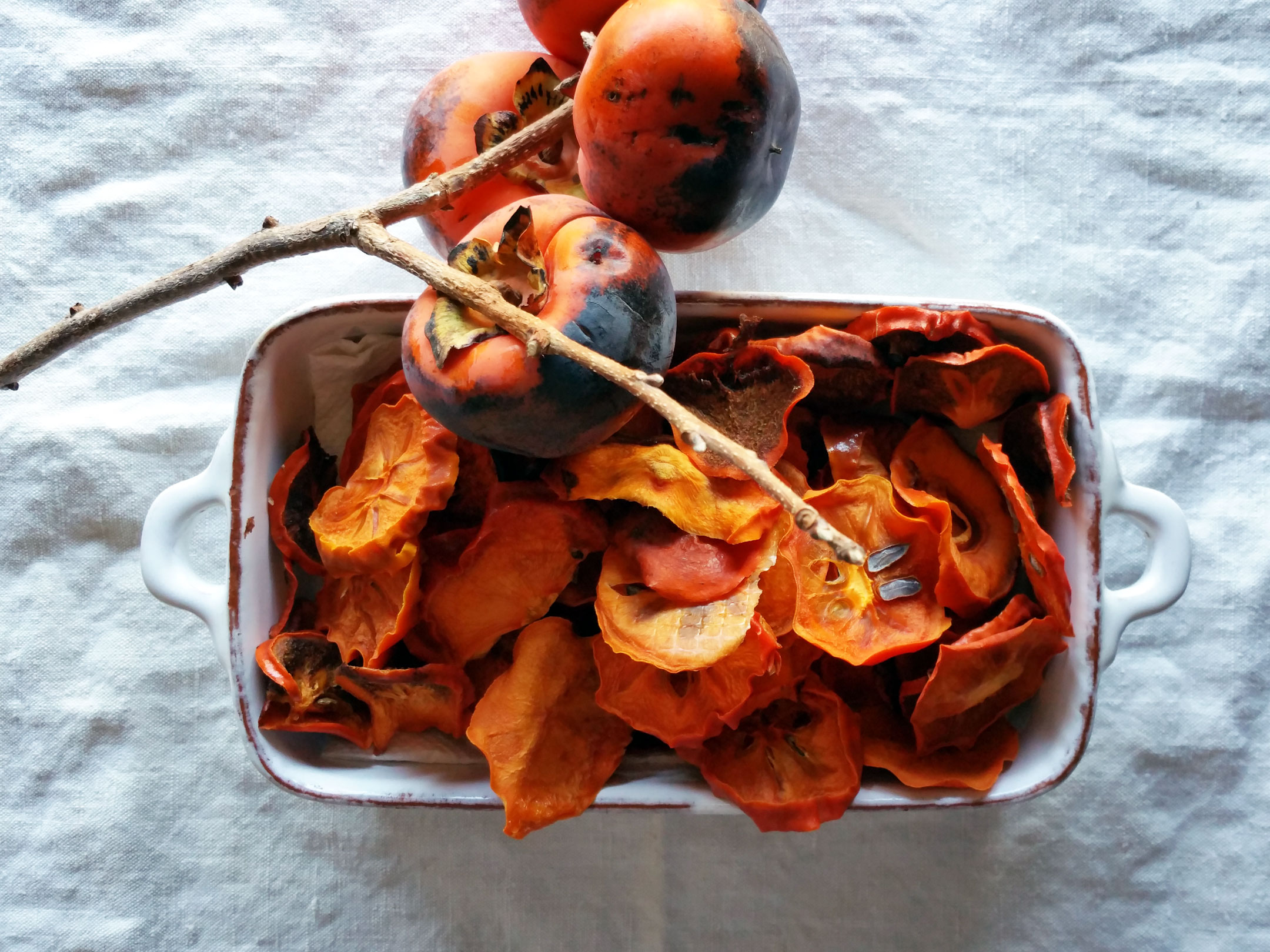
Dried Persimmons
On November 26, 2014 by sixtyacrebakerPersimmons seem to be a bit misunderstood. Some varieties need to ripen on the tree and be very soft, otherwise they are astringent, while others can remain very firm and be sweet. Personally, I prefer Fuyu persimmons. They do well in the area where we live, and grow abundantly through the fall. Firm and sweet, they are delicious off the tree, sliced in salads, frozen and enjoyed as an icy treat, and dehydrated into sticky sweet submission. To dry persimmons, you do not need a dehydrator, but it helps. If using a dehydrator, simply slice the persimmons in 1/4-1/2″ slices and set on the drying tray. Turn the heat of the machine to 130-135F for about 8 hours. Look at the fruit after about 6 hours to check on progress, they may be done. If not, check every hour until they are still a bit supple, but not wet. Leave to cool in the dehydrator for another 2 hours or so…or overnight.
If using oven: turn oven to lowest setting–preferably 130-135 if you can get it that low. Line your baking sheet with a silpat or parchment paper. Proceed as described above.
You may also choose to dry the persimmons whole. You can do that by tying baker’s twine, or other type of string to the stem of the persimmon. Tie one persimmon onto each end of the string. Prop a broomstick or other apparatus in a warm window sill. Hang the persimmon on the pole/broomstick/etc. The strings will hang over the middle with a persimmon on either side. After a day or two, give each persimmon a little massage, a gentle squeeze on all sides. Continue doing this each day until the persimmon has completely dried out and formed a bit of a sugary crust on the outside. This may take several weeks and is nearly impossible in damp conditions. If the fruit shows signs of mold, throw the fruit away.
Dried persimmon makes a wonderful sweet as candy snack. It is also great in granola, oatmeal, and trail mix. You can reconstitute with water for use in salads or tagines. Soak in wine and spices for a compote. The uses are almost endless
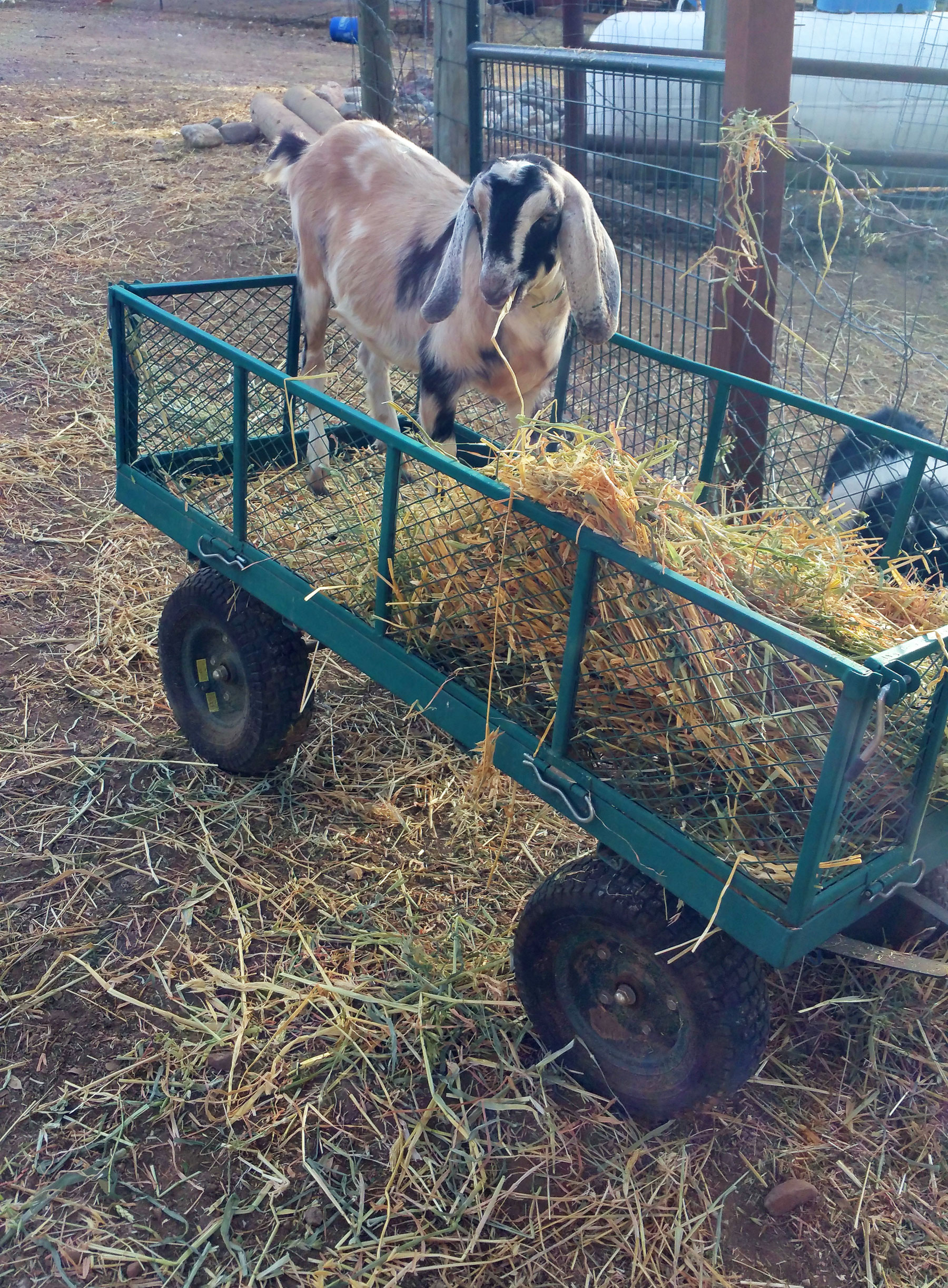
Pixie
On November 25, 2014 by sixtyacrebakerPixie is my pet. And when I say pet, I am talking in the context of favoritism. Although, some may argue that she is also our pet. Pixie was a preemie. Her dam was so confused about the whole situation that she actually dropped Pixie out while walking and basically never looked back. We tried to force a maternal instinct, but unfortunately because of her tiny size (less than 3lbs) we couldn’t take a chance that eventually her mom would start mothering. Pixie has a brother who was born first and bigger. He was able to get out of moms way when she rolled over, or mistakenly sat on him. Pixie just couldn’t do it. It took her a full two days to get her legs under her. Simply, she was weak and small and not going to make it. We put Pixie on a bottle and moved her into the house. She was on a every two hour feeding schedule, and lived in an beer case for the first week. She was my constant companion for the first month of her life…and I hers. As she grew stronger and bigger, we moved her in with the other goats during the day…in an attempt to socialize her. At 3 months old, we weaned her completely and put her with the herd.
She had a hard time making friends. Occasionally, we would see her play with the other doelings…but she didn’t have her mom to pal around with; while all the other kids have their mom. It was getting more and more noticeable that she wasn’t bonding with anyone, and her spirits began waning.
Seriously. I know it sounds odd, but it is true. Pixie was acting depressed. She no longer responded when we called her name, and recently she stopped eating. I was sure she was ill. I spent time with her each evening…sitting with her while she ate her dinner. But this past week she stopped coming to me. She would just stand in a corner and occasionally let out a sad cry. We’ve been so worried about her, fearing she was ill, and that we might lose her. Goats have a tendency to hide their illness until it is almost beyond repair. They are hearty, but fall quickly. A loss of Pixie would be difficult.
Mike suggested letting her roam about the yard with the dogs during the day. She was raised with the dogs in the house…so it was worth a shot. Maybe the dogs were her herd. First I let her out and had her follow me around for evening chores. She was like Eeyore. Her head was hung and she could barely handle the long walks between tasks. I was sure she was ill. Then, we let her in the yard first thing in the morning and had her wander about as she pleased. We took her temperature..normal, checked her for worms, no problem, and massaged her belly to give her rumen a kick-start. Signs were good that medically she was most likely okay. I gave her a double shot of a vitamin drench, and a handful of her favorite grain treat. And she sat in the yard barely able to lift her head.
A few hours passed and there was a noticeable change in her. She was on her feet and trying to devise a way to get on top of the hay pile. She was hungry and thirsty. When I walked the yard doing evening chores, she was at my side, skipping a bit. We let her sleep in the nursery with the baby lambs and their moms. The sheep are much less aggressive around food than the goats…and the lambs seemed to enjoy the prospect of having another playmate. Pixie found a peaceful spot to sleep and settled in for the night.
In the morning, as I was watching the sunrise through the bedroom window, I was startled by a tap at the patio door. Mike was already out doing morning feeding, and he had apparently let Pixie into the yard. She had happily bounded towards the house and was eager to say hi. We are so relieved, but still cautious.
She is eating well, jumping on tables and chairs and cars. She stops by the house occasionally to see what is going on and to grab a snack. She seems happy. The best part is, when we call her name, she calls us back. I am thankful that this story has a happy ending.
Although our animals all have a purpose on the ranch, and our goats are livestock, we care about them. They each have a distinct personality and respond to us differently. It is difficult not to get attached. Has heartbreaking as it is, I don’t want to be detached. I want to know all of our animals, and them to know us. I want their lives to be stress free and healthy. I am well aware that the day may come when we have to cull, harvest or slaughter our livestock. But until that day comes, they will have a good life. The best we can give them. Especially if they will end up on the table.
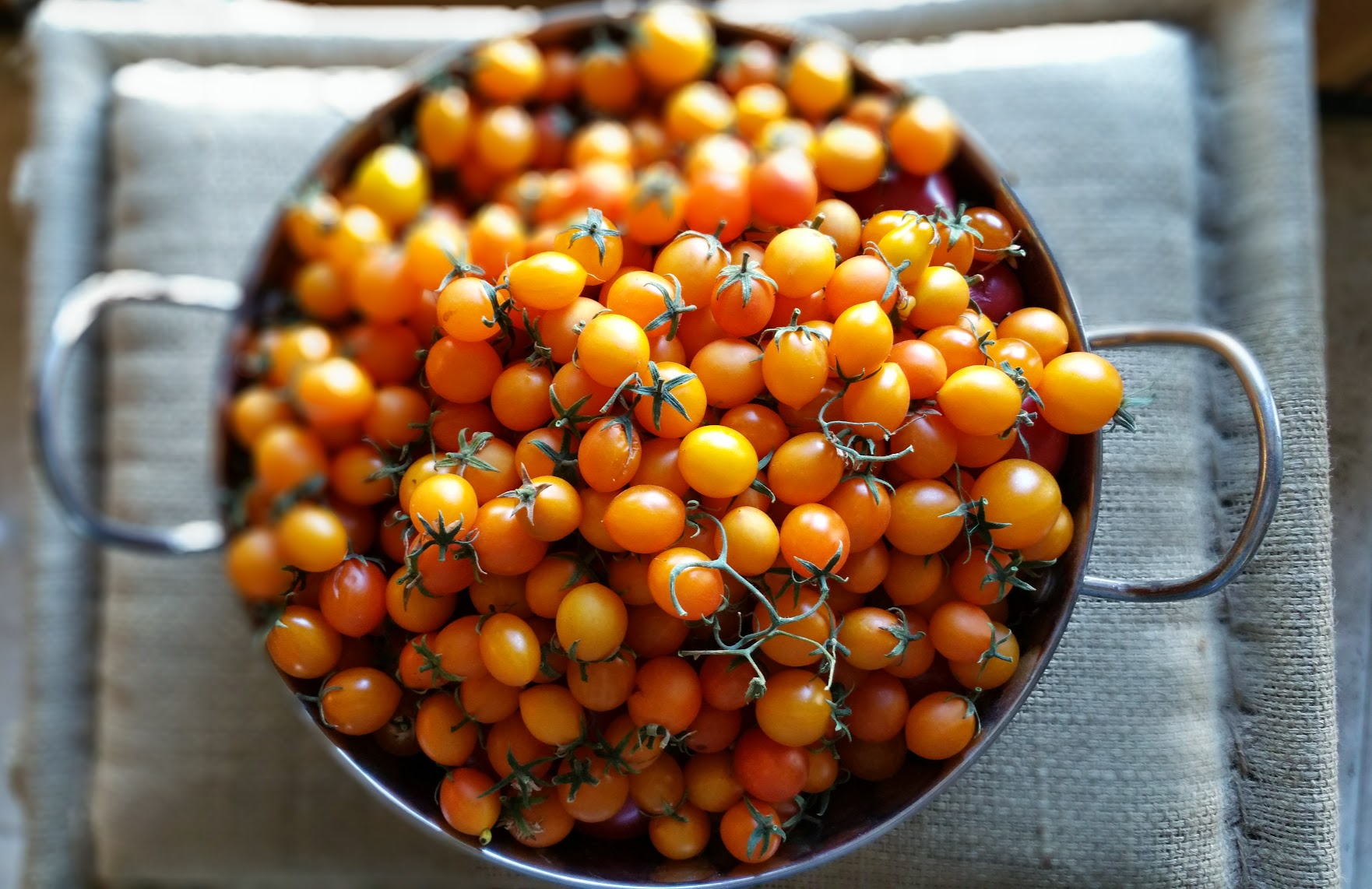
Tomatoes
On October 24, 2014 by sixtyacrebakerI have loads of these gorgeous, albeit small, tomatoes. My sink is a bath of hot soapy water, as I prepare jars for canning. My counter tops look as if a produce van exploded just outside the kitchen window. When it is all said and done, I will have plenty of jars for winter, as well as gifting. Question is…what shall I make? Tomato jam, sauce, chutney? So many possibilities. What I do know for sure is that I will be making a big jug of tomato infused vodka for the day after, the night before.
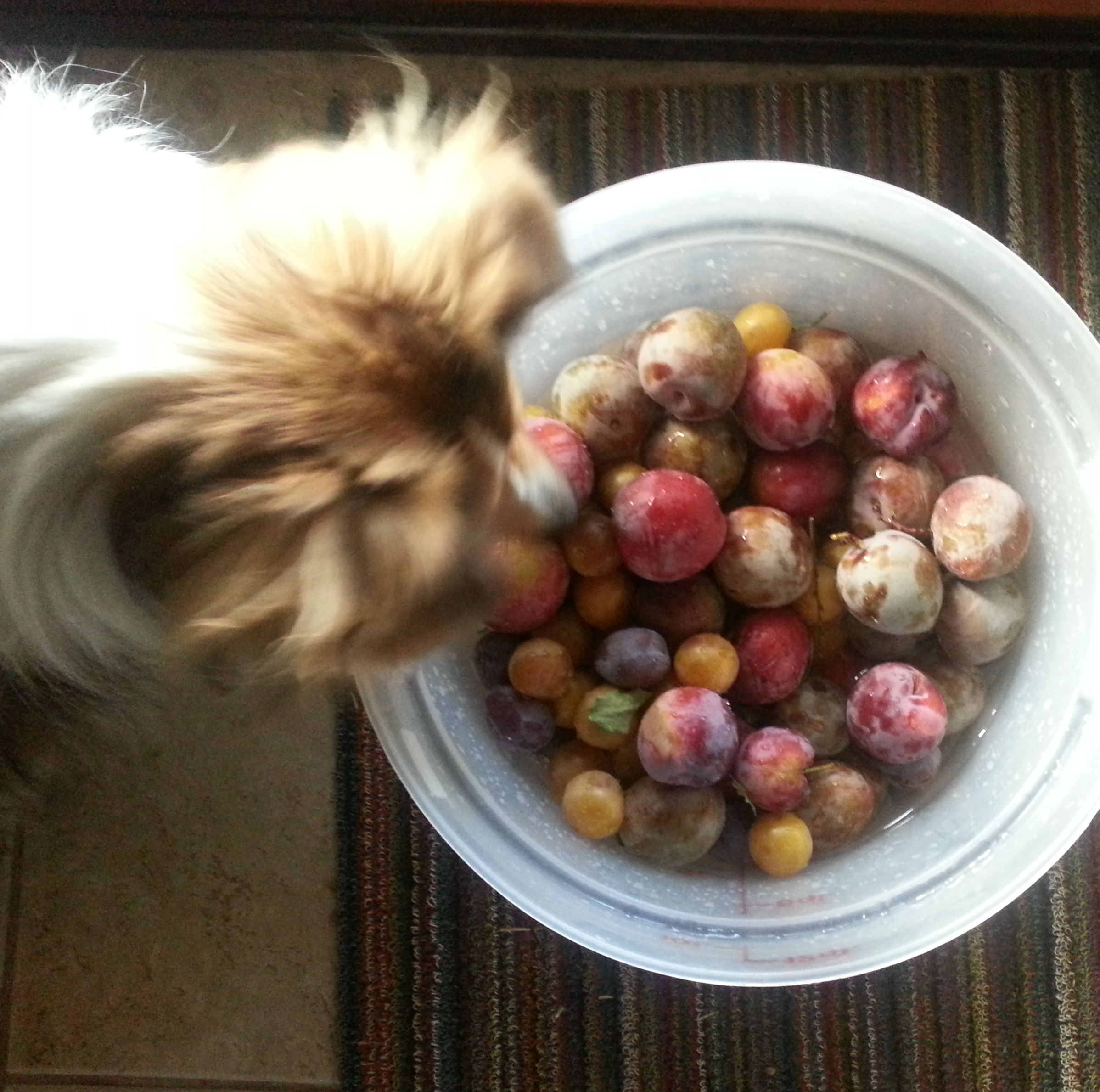
Plums
On September 27, 2014 by sixtyacrebakerThe weather is turning. This morning we picked the almost last bit of plums. Scout is a good early morning companion; she loves fruit as a treat. These bright little orbs, appear to her, to be a bucket of balls. She is very attentive her inspection flawless
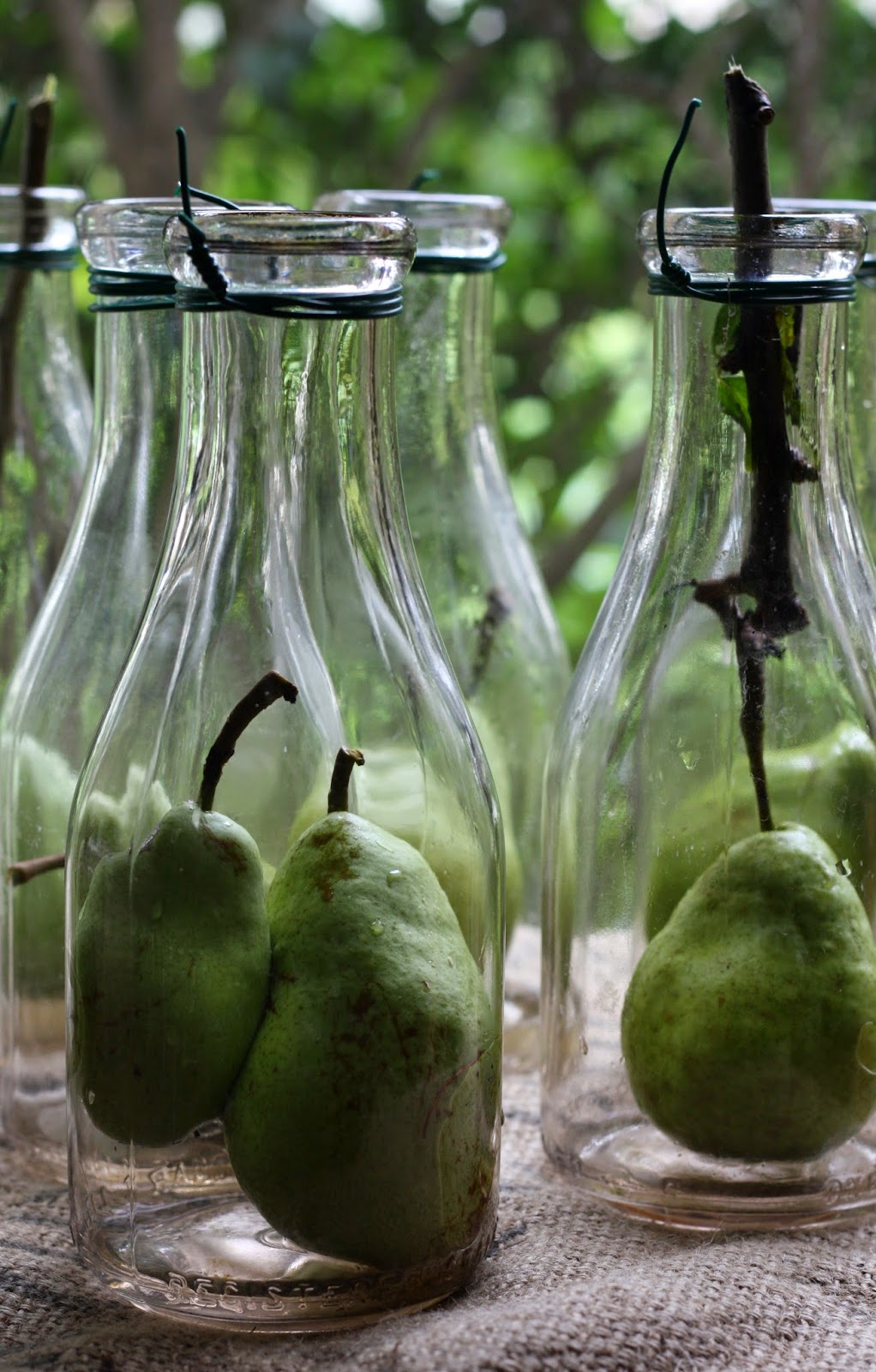
message in a bottle
On September 25, 2014 by sixtyacrebakerSpring arrives and we run in full sprint preparing and tending. Summer has us watching, patiently waiting. Fall arrives with a prize: fruit grown in.the. bottle. Almost complete, almost. Large jars of ripe pears; bathing in brandy, infuse for months, monitored sip after sip after sip. When the time comes, the brandy pours; briefly veiling the pear. Bottles corked, ready for night capping and mood enhancing, hold secrets of the garden and whispers of the trees.
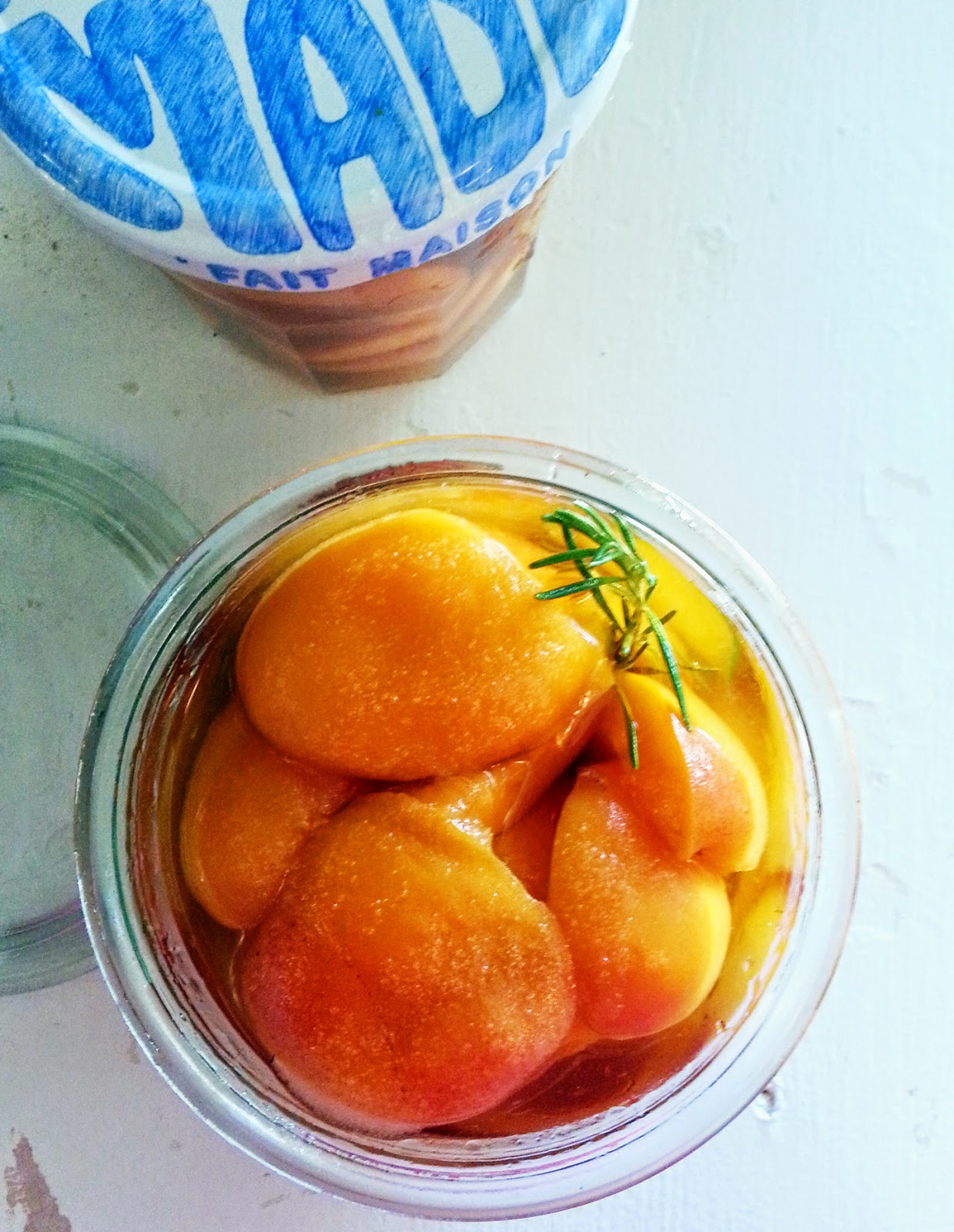
brandied apricots
On June 21, 2014 by sixtyacrebakerWe picked a bucket load of apricots the other day, and i have been working to preserve them for our winter larder. This year I have decided to brandy some. Which is a fancy way of saying,infusing with brandy. I’ve loaded my jars with freshly washed fruit (sliced in half and pitted), a sprinkle of sugar (about a tablespoon per jar),and poured on the brandy. In some i added a few extra bits, rosemary in one, cinnamon stick in another, vanilla bean in a third. There are so many lovely combinations to try. I am popping these onto a shelf, in a cool pantry. The fridge would be a great place too-if only i had room in the fridge
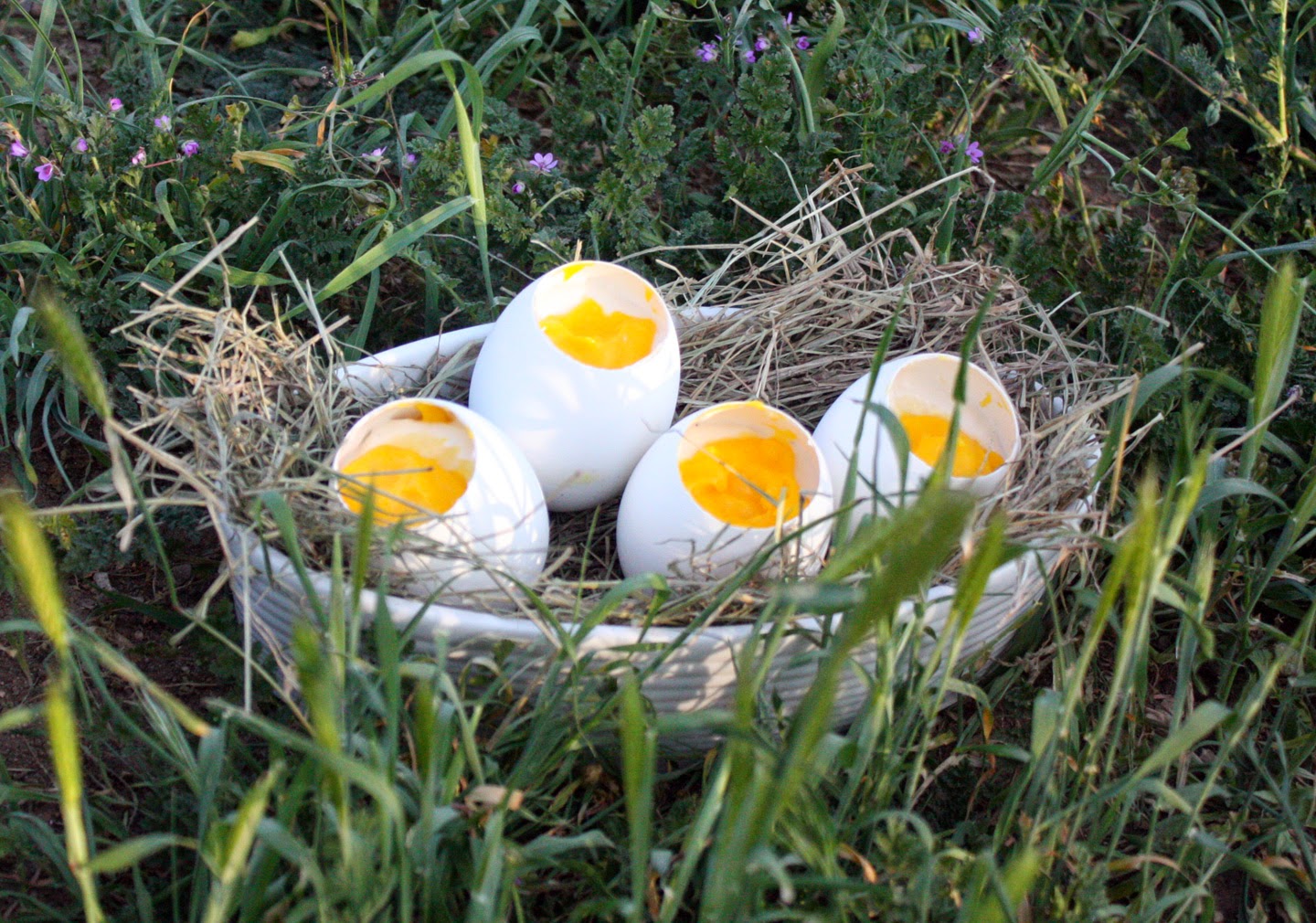
Sweet Eggs
On May 8, 2014 by sixtyacrebakerCome spring we bring it outside. Entertaining is a bit more relaxed and food becomes a bit less fussy, perhaps a tad more whimsical. Certainly, more seasonally driven. We keep chickens, ducks and geese; which means a generous supply of eggs. When putting together a weekend brunch, I love to serve sweet eggs. Very simple, and darling on display, these eggs are filled with vanilla yogurt and lemon curd.
Sweet Eggs
egg cups
emptied and cleaned goose, duck or extra large chicken eggs
-using an egg topper is by far the easiest way to get those perfect edges.
-while the eggs are uncooked, take the top off. separate the whites and the yolks as you empty the shell. use the yolks for your curd, the whites for another delicious recipe.
-you must be gentle when washing the shells, but you must be very thorough in the washing. there may be a layer of membrane attached to the interior of the shell. make sure you get that completely out. it comes out easier when you run water through it. once the membrane is cleared, use a good soap and hot water to get it completely cleaned out. let them air dry with good air-flow.
-you can either set the eggs in egg cups, or use the top inverted and glued to the bottom of the egg to create a stand. you may also just want to place in a small bowl, or in a large bowl on top of artificial grass (or if you have access, hay or straw)
plain or vanilla yogurt
vanilla extract-optional
brown or granulated sugar -optional
if you are using plain yogurt and wish to sweeten it up a bit (i recommend doing so, particularly if you have a nice tart lemon curd), add just a touch of sweetness with your sweetener of choice. i like brown sugar because it takes very little and adds a bit of a caramel flavor to the yogurt. start with 1 tsp per 2 cups and add more to taste. the same with the vanilla.
lemon curd
your favorite lemon curd recipe
-martha has a nice one HERE
-make the lemon curd as directed and let cool completely
to assemble
Place the yogurt and lemon curd in separate decorating bags (alternatively you can use a small spoon). layer directly into the shell starting with the yogurt. fill the shell approximately 1/3 full with the yogurt. add a thin (max 1/4″) layer of lemon curd. add more yogurt to almost reach the top of the shell, and top with more curd, placed to resemble an egg yolk.
serve with demi-tasse spoons.
you may also add gingersnap crumbles or graham cracker crumbles to the bottom for additional flavor and a bit of crunch. serving with a bit of granola is a nice compliment.
for something really fun, fashion sugar cookies into “toast soldiers” and pop them right in to look like a soft boiled egg and toast.
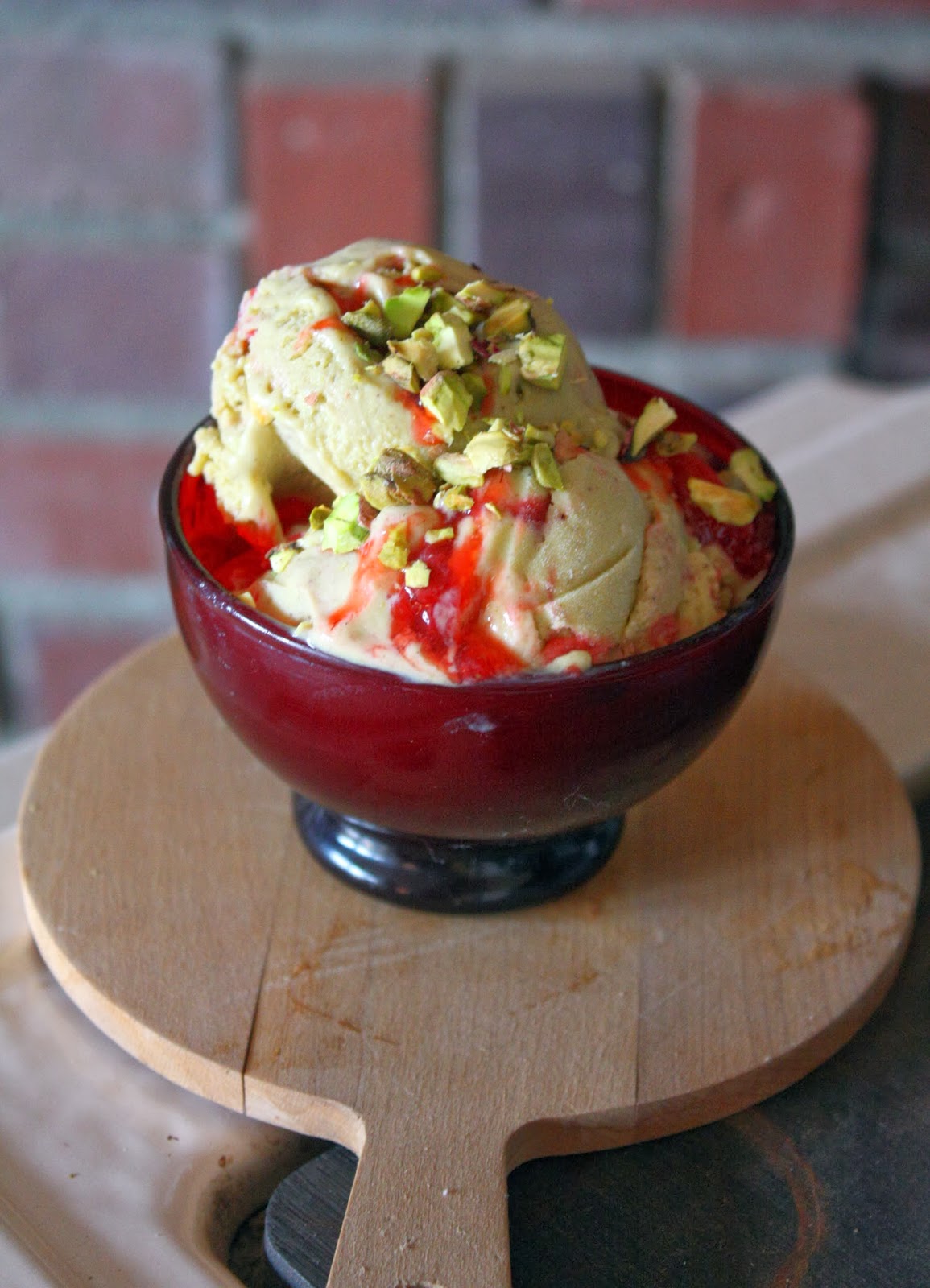
Pistachio-Strawberry Ice Cream
On March 12, 2014 by sixtyacrebakerA warm winter makes way for an early harvest of strawberries. Meandering down a country road this weekend past, i happened across a roadside stand loaded with berries and heaps of pistachios,locally grown. To keep up with our highly productive flock, I find myself dreaming up custards.
frozen custards
Frozen custards made from backyard eggs, fresh milk, and farmstand goodies.
pistachio-strawberry swirl ice cream
1 cup unsalted (roasted and shelled) pistachios
1 1/2 cups milk
1 1/4 cup granulated sugar
7 large eggs yolks
pinch salt (sea or kosher)
2 cups heavy cream
1 tsp vanilla
1 cup strawberry preserves
1/2 cup chopped pistachios (optional)
whisk the egg yolks, salt, and 3/4 cup sugar. place milk and the pistachios in a blender and puree until the nuts are completely liquid and smooth. add 3/4 cup sugar and place over low heat. warm to a simmer. remove from heat and whisk into the eggs and sugar mixture. tip back into the saucepan and cook over very low heat, stirring continually with a rubber spatula. do not allow to boil, and cook until it just begins to thicken to nappe. remove from heat and pour through a sieve into a clean bowl. stir in vanilla and heavy cream. refrigerate fromr 6 hours to overnight. freeze according to ice cream manufacturer instructions.
once the custard is frozen, transfer it to a freezer-safe container. swirl in the strawberry preserves and the chopped pistachios (if using)
*if you choose to make your strawberry preserves, simply place 2 cups of roughly chopped strawberries in a saucepan. taste for sweetness. squeeze the juice of 1/2 lemon. add sugar according to sweetness. add up to 1 1/2 cups of sugar (less if sweet strawberries, more if not sweet). cook at a simmer until strawberries break down and soften and they sit in a thick glaze.
refrigerate until needed

And Goes Another Year
On February 22, 2014 by sixtyacrebakerThree birthdays ago, I wrote from a small desk; in a cozy room on a sheep farm. I awoke with the sun to find newly birthed lambs; ready for a warm bottle, i was charged to provide.That day was life changing literally.Today,my birthday 3 years hence, I write from a small desk; in a roomy greenhouse,on my own farm.
Where:
i awake with the sun
.. the rooster
…the bleating goats
..hungry pigs
… herd of sheep
..and a wee little lamb of my own
